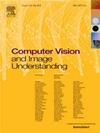Joint Generating Terminal Correction Imaging method for modular LED integral imaging systems
IF 4.3
3区 计算机科学
Q2 COMPUTER SCIENCE, ARTIFICIAL INTELLIGENCE
引用次数: 0
Abstract
Integral imaging has garnered significant attention in 3D display technology due to its potential for high-quality visualization. However, elemental images in integral imaging systems usually suffer from misalignment due to the mechanical or human-induced assembly within the lens arrays, leading to undesirable display quality. This paper introduces a novel Joint-Generating Terminal Correction Imaging (JGTCI) approach tailored for large-scale, modular LED integral imaging systems to address the misalignment between the optical centers of physical lens arrays and the camera in generated elemental image arrays. Specifically, we propose: (1) a high-sensitivity calibration marker to enhance alignment precision by accurately matching lens centers to the central points of elemental images; (2) a partitioned calibration strategy that supports independent calibration of display sections, enabling seamless system expansion without recalibrating previously adjusted regions; and (3) a calibration setup where markers are strategically placed near the lens focal length, ensuring optimal pixel coverage in the camera frame for improved accuracy. Extensive experimental results demonstrate that our JGTCI approach significantly enhances 3D display accuracy, extends the viewing angle, and improves the scalability and practicality of modular integral imaging systems, outperforming recent state-of-the-art methods.
模块化LED集成成像系统的联合生成终端校正成像方法
集成成像由于具有高质量可视化的潜力,在三维显示技术中引起了极大的关注。然而,在整体成像系统中的元素图像通常遭受由于机械或人为引起的装配在透镜阵列中的不对准,导致不良的显示质量。本文介绍了一种为大规模模块化LED集成成像系统量身定制的新型关节生成终端校正成像(JGTCI)方法,以解决生成元素图像阵列中物理透镜阵列光学中心与相机之间的不对准问题。具体来说,我们提出了:(1)一种高灵敏度的校准标记,通过精确匹配透镜中心和元素图像中心点来提高对准精度;(2)分区校准策略,支持显示部分的独立校准,无需重新校准先前调整的区域,即可实现系统的无缝扩展;(3)校准设置,其中标记策略性地放置在镜头焦距附近,确保相机框架中的最佳像素覆盖,以提高精度。大量的实验结果表明,我们的JGTCI方法显著提高了3D显示精度,扩展了视角,提高了模块化集成成像系统的可扩展性和实用性,优于最近最先进的方法。
本文章由计算机程序翻译,如有差异,请以英文原文为准。
求助全文
约1分钟内获得全文
求助全文
来源期刊

Computer Vision and Image Understanding
工程技术-工程:电子与电气
CiteScore
7.80
自引率
4.40%
发文量
112
审稿时长
79 days
期刊介绍:
The central focus of this journal is the computer analysis of pictorial information. Computer Vision and Image Understanding publishes papers covering all aspects of image analysis from the low-level, iconic processes of early vision to the high-level, symbolic processes of recognition and interpretation. A wide range of topics in the image understanding area is covered, including papers offering insights that differ from predominant views.
Research Areas Include:
• Theory
• Early vision
• Data structures and representations
• Shape
• Range
• Motion
• Matching and recognition
• Architecture and languages
• Vision systems
 求助内容:
求助内容: 应助结果提醒方式:
应助结果提醒方式:


